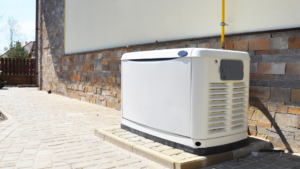
Prices run from $4000-$25,000. Before making such a substantial investment, take some time to consider the various factors that affect the cost. Understanding them will help you budget effectively and select the best model for your home.
Generator Size
Like cars, large generators cost more than small ones. A portable generator, the type you might take camping, produces 2-10 kilowatts (kW) ‒ enough to power a handful of small appliances and a few lights. A whole-house generator, on the other hand, needs to produce 13-25 kW. Exactly how much depends on the size of your home.
| Home | Generator | Cost |
| 1,500 Square Feet | 13-16 kW | $3,000-$5,000 |
| 1,500-3,000 Square Feet | 17-20 kW | $4,000-$6,000 |
| 3,000-5,000 Square Feet | 22-25 kW | $4,500-$12,000 |
| 5,000+ Square Feet | 30-48 kW | $10,000-$25,000 |
Fuel Type
Fuel is one of the most important factors to consider when choosing a generator. It not only affects the initial price, but also your long-term costs. The most popular fuels on the market are:
- Gasoline. Gas generators are affordable, but small and there are few capable of powering an entire house. Gasoline is widely available. However, it has a short shelf-life (3-6 months), so unless you use your generator regularly, a lot of it will wind up going to waste. The average cost is $500-$3,000.
- Liquid Propane. Propane burns cleaner than diesel and gas, and lasts almost indefinitely. While it’s possible to run small generators with portable propane tanks, most will require you to install a large storage tank instead. Costs range from $2,000-$21,000.
- Natural Gas. Natural gas generators tend to be more expensive, but more convenient at the same time. They’re connected to the same fuel lines that power the other gas appliances in your home, such as your oven, dryer, and water heater. Natural gas is cheaper than gasoline, but that doesn’t necessarily mean a natural gas generator is less expensive. Some consume fuel at a higher rate, which adds to long-term maintenance. A natural gas generator costs $2,000-$24,000.
- Diesel. Diesel generators are more efficient than gasoline or natural gas. In fact, the larger they get, the better they run. However, diesel is also the most expensive fuel on the market, so their maintenance costs tend to be a little higher. Expect to pay $3,000-$25,000 for one.
Additional Expenses
Besides sticker price and fuel costs, there are a few additional factors you’ll have to account for when purchasing a whole-house generator. These include:
- Labor. Though it’s possible to install a whole house generator on your own, it’s generally best to hire a contractor. Contractors may charge a flat rate or itemize their charges. Depending on the size of the job, labor costs can run from $1,500-$5,000.
- Permits. Some cities require you to obtain a permit before installing a whole-house generator and pay a small fee, normally $100-$200.
- Concrete Pad. Poured concrete pads provide a stable foundation, necessary to keep the generator level, minimize vibration, and prevent water from pooling around the base. If you don’t already have one, installation costs $50-$75 per square foot.
- Transfer Switch. There are two types of generators. Manual start generators require you to activate them by hand, while stand-by generators activate automatically when the power goes out. Stand-by generators require a transfer switch, which allows your circuit board to disconnect from the municipal power supply and draw power from your generator instead. A transfer switch costs $50-$1,300. Unless you have experience working with wires and circuitry, you’ll need an electrician to install one, which may cost an additional $400-$2,000.
Protect Your Electrical System
Power outages are hard on homes as well as homeowners. Shutting off and restoring electrical current increases the strain on your internal wiring. This type of damage isn’t covered by home insurance, but it is covered by Agway. Our EnergyGuardTM program protects your electrical system from breakdowns caused by wear and tear.
When a malfunction occurs, our customers don’t have to spend hundreds of dollars out of pocket. Instead they call us. We schedule the repairman and pay for all covered parts. There are no service fees or deductibles. Everything is covered by your monthly rate. Best of all, once your enrollment is accepted you are covered automatically. Don’t wait. Sign up today and save!